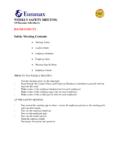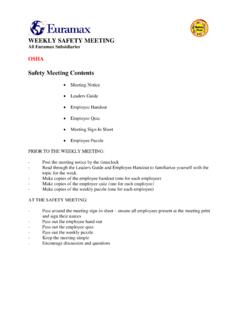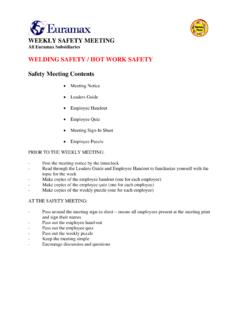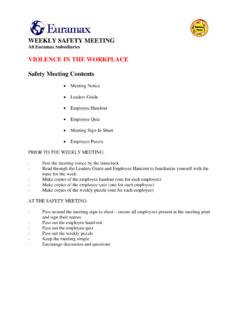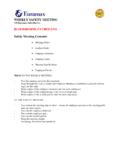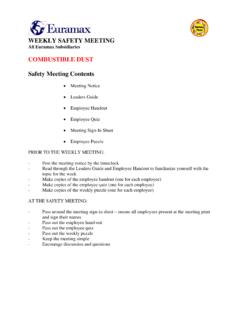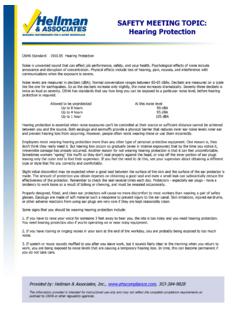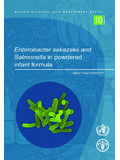Transcription of WEEKLY SAFETY MEETING FIRST AID Safety …
1 WEEKLY SAFETY MEETING All Euramax Subsidiaries FIRST AID SAFETY MEETING Contents MEETING Notice Leaders Guide Employee Handout Employee Quiz MEETING Sign-In Sheet Employee Puzzle PRIOR TO THE WEEKLY MEETING : - Post the MEETING notice by the time clock - Read through the Leaders Guide and Employee Handout to familiarize yourself with the topic for the week - Make copies of the employee handout (one for each employee) - Make copies of the employee quiz (one for each employee) - Make copies of the WEEKLY puzzle (one for each employee) AT THE SAFETY MEETING : - Pass around the MEETING sign-in sheet ensure all employees present at the MEETING print and sign their names - Pass out the employee hand-out - Pass out the employee quiz - Pass out the WEEKLY puzzle - Keep the MEETING simple - Encourage discussion and questions WEEKLY SAFETY MEETING NOTICE THIS WEEK, OUR SAFETY MEETING WILL COVER FIRST AID TIME: _____ DATE: _____ PLACE.
2 _____ WEEKLY SAFETY MEETING All Euramax Subsidiaries FIRST AID Leaders Guide Page 1 EURAMAX PROCEDURE REFERENCE: : FIRST Aid Personnel : Trauma Kits MEETING OBJECTIVE: A solid FIRST aid program involves more than just making sure the FIRST aid kit is stocked and easy to locate. Of course, the kit is important in an emergency, but it won t do much good unless people know how to use it. The purpose of this MEETING is to outline the FIRST aid procedures and to provide the basic information needed to report emergencies. Of course, FIRST aid treatment should only be given by trained personnel.
3 However, it s important for everyone to know what to do during the FIRST critical moments of a medical emergency. MEETING PREPARATION: Read the Euramax procedure, understand the contents, and ensure compliance. Gather the phone numbers of outside emergency services, the names of the employees at the facility who are trained in FIRST aid and/or CPR. Make copies to distribute at the MEETING . Call your Red Cross or your local hospital to find out when and where FIRST aid and CPR courses will be offered. Bring this information with you to the MEETING . Review the employee handout to see if there are any other materials you wish to bring to the MEETING .
4 Use a flip chart during the discussion to write key points and employee responses. This technique visually reinforces your instruction. (Before the MEETING , you may choose to write on the chart the eight steps of medical emergency response that will be presented.) MATERIALS CHECKLIST: Copies of emergency phone numbers/names Flip chart and marketing pens WEEKLY SAFETY MEETING All Euramax Subsidiaries FIRST AID Leaders Guide Page 2 MEETING INTRODUCTION If someone in this room collapsed right now, would you know what to do? Would you know how to get emergency medical services on the scene?
5 Would you know how to evaluate the victim s condition and determine what FIRST aid measure needed to be taken? What can you do if you haven t had training in FIRST aid and CPR? What should you do if you have? Today, we re going to talk about how to respond in a medical emergency so that you can help the victim and do no further harm. More than six million people are injured or become ill on the job every year. When those on the scene know what to do in an emergency and respond quickly to get needed medical assistance on the scene, the victims stand a much better chance of surviving and recovering.
6 The Red Cross and other organizations provide training in FIRST aid and CPR. The more people that know about how to respond in an emergency, the more comfortable they are and that means their efforts are also more effective. Suggest that all employees who are not already FIRST aid and CPR certified take the short training course with your local Red Cross or hospital. Give employees the information about the times and locations of these courses. Make sure employees know where the FIRST aid and trauma kits are located. Explain that in a real emergency, everything happens very quickly, and many of the steps that you are going to cover today are taken almost simultaneously.
7 But today, for the sake of clarity, you are going to treat them as eight distinct steps. Step #1: Stay calm. Question: Why is it important to remain calm? Answer: To make a real, positive difference in a medical emergency, you need to keep yourself and others from panicking and reacting in dangerous ways. Remaining calm will allow you to act rationally. WEEKLY SAFETY MEETING All Euramax Subsidiaries FIRST AID Leaders Guide Page 3 Question: How can you help yourself remain calm? Answer: Take deep breaths. Talk to the victim and co-workers on the scene.
8 Stay focused on what you need to do to help the victim and protect yourself. Question: What if the sight of blood makes you faint? Answer: Know your own limits. Know what you can and can t do in an emergency. If the sight of blood makes you faint, try to help in some other way. Offer to go call for help. Offer to wait by the street entrance to escort the EMT s to the victim. Step #2: Make sure the scene is safe. Explain that when employees confront emergency situations, it could be dangerous for them to enter the area near the victim. They need to ask themselves FIRST , Is the area safe for me?
9 It might not be. There may be hazards that could injure them in their effort to rescue a victim. Question: What kinds of hazards might you face in a medical emergency? Answer: Live wires Toxic chemicals or vapors Danger of fire or explosion Danger of a cave-in Question: What should you do if there a threat to your own SAFETY as a rescuer? Answer: Call for help. Don t be a hero and rush in. You are only risking harm to yourself and that means you won t be much help to the victim. WEEKLY SAFETY MEETING All Euramax Subsidiaries FIRST AID Leaders Guide Page 4 Step #3: Evaluate the victim.
10 Question: If it s safe to approach a victim, what should you do? Answer: Ask Are you okay? Do you need help? This may sound like a strange question to ask someone who is obviously injured. But you must do this for your own legal protection. A conscious victim must give you permission to administer FIRST aid. Question: What should you do next? Answer: Ask what s wrong and let the victim know that you intend to help. Question: What if a victim is unconscious? Answer: If a victim doesn t respond, immediately call for help, then check the ABCs. We ll talk about the ABCs a little later.
